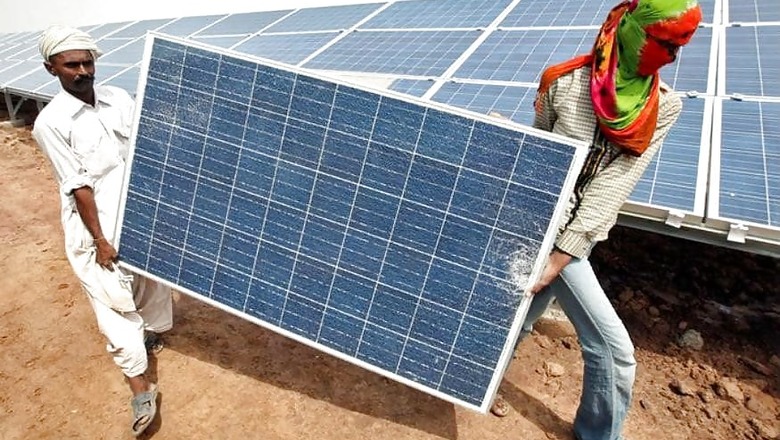
views
New Delhi: Prime Minister Narendra Modi talked about India's plans to harness solar energy at the World Economic Forum in Davos on Tuesday. In November last year, PM Modi had set an ambitious target of having 175 gigawatts (GW) installed capacity of renewable energy by 2022. Of this, 100 GW is expected from solar power and 60 GW coming from wind power projects. However, whether the government can achieve the goal is a matter to be discussed.
As of December 15, 2017, India had an installed solar power capacity of 16.68 GW, New and Renewable Energy (MNRE) minister RK Singh told Parliament on January 4. The installed operational capacity of wind energy was at 33 GW, the minister added.
Singh also talked about including small hydro and bio-power units in the ambit of renewable energy. Their combined installed capacity adds up to 12.4 GW by the end of 2017.
With three years to go, the Centre needs 113 GW of renewable energy to achieve the target, meaning 37.67 GW of installed capacity to be added per year.
“It is no doubt a tough ask. The renewable energy space has taken off for sure but whether the target will be achieved or not is something which needs to be seen. We have seen the solar sector adapting very well to the Indian market. The government through green incentivisation has created an apt demand and supply module. It is a very positive move towards meeting the target but the goal is very high. I am not negating the fact that it can’t be achieved but the remaining three years need excellent policies and participation,” said Nithin Chandra, partner, AT Kearney.
With 200 million consumers, India’s power sector is the third largest in the world after China and the US.
“2018 has been a good start for the Indian renewable energy sector. The fag end of 2017 saw a bit of a lag which has been recovered right in the beginning. It will be interesting to see how it pans out throughout the year," said Samir Kanabar, partner, EY, a consultancy.
According to a report by Reuters, India will need at least $125 billion to fund its ambitious plan to increase the share of renewable power supply in the country's grid. In 2015, India had said that an investment of $100 billion in the seven years to 2022 would be needed to meet its targets.
Putting investments needs in context, renewable energy minister said India will set up a $350 million fund to finance solar projects. However, it is yet to be institutionalised.
India receives twice as much sunshine as European nations, hence fuelling the confidence to make solar energy central to its renewable expansion. The government plans that by 2030, renewable energy will make up 40% of installed power capacity, as against 18.2% at the end of 2017.
While experts feel the road ahead is tough, significant progress has been made as well.
After months of lag, the solar power industry now has over 4 gigawatts (GW) of projects that it can bid for across the country.
In the first week of 2018, state-run Solar Energy Corporation of India (SECI) tendered out over 1,200 MW of projects, including 750 MW in Andhra Pradesh, 200 MW in Karnataka, and 275 MW in Uttar Pradesh.
The recovery began in December 2017, when around 3,000 megawatts (MW) projects were auctioned out by the SECI and various state governments, which included 1,300 MW in Maharashtra, 860 MW by Karnataka, and around 750 MW.
The solar power sector witnessed a sharp fall in activity in October and November last year as it battled stagnant power demand and rising solar panel costs therefore commissioning just over 3000 MW of solar power as of December 2017 as against the target of 15,000 MW for the last financial year.
Last year, the country added 5.53 GW of incremental solar power capacity against a target of 6 GW. The target for 2018 is 10 GW.
According to a report by Central Electricity Authority, capacity addition of 27.07 GW of renewable energy has been reported during the last three and half years.
MNRE in a statement issued as year-ender for 2017 said, “Confident by the growth rate in clean energy sector, the Government of India in its submission to the United Nations Frame Work Convention on Climate Change on Intended Nationally Determined Contribution (INDC) has stated that India will achieve 40% cumulative Electric power capacity from non-fossil fuel based energy resources by 2030 with the help of transfer of technology and low cost capital.”
To sum it up, Kanabar said, “Policies and incentives are the only two ways this target can be achieved.”
















Comments
0 comment